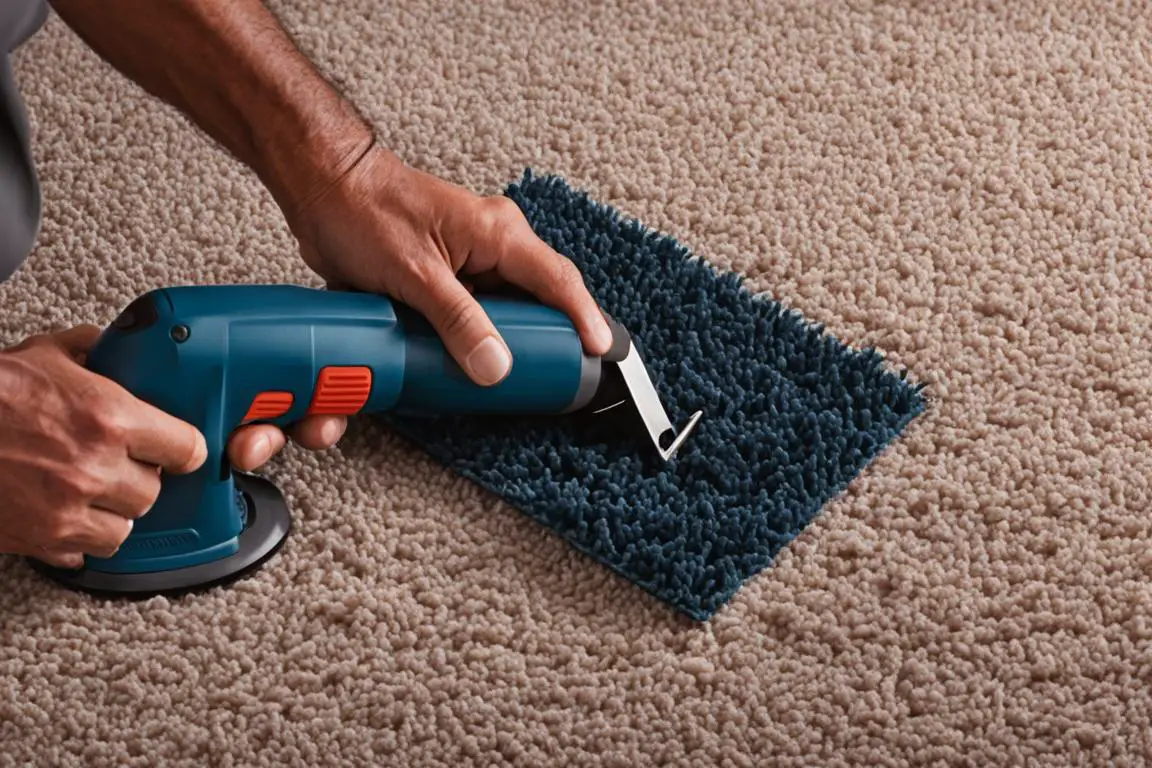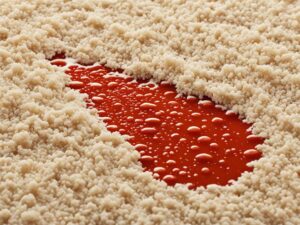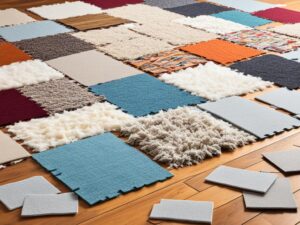If you have noticed bumps or ripples in your wall-to-wall carpet, you’re not alone. This is a common problem that can occur due to various factors such as improper installation, deteriorating backing, or environmental factors like humidity. Carpet stretching and repair can help eliminate these bumps and give your carpet a smooth and flawless appearance. In this article, we will explore the techniques and methods for removing bumps from your wall-to-wall carpet.
Key Takeaways:
- Carpet bumps can be caused by improper installation, deteriorating backing, or environmental factors.
- Carpet stretching is an important process for removing bumps and ripples.
- Repairing damaged areas of the carpet ensures a flawless look.
- The process of restretching a carpet involves several steps.
- For small bumps, DIY techniques such as using a knee kicker may be effective.
Understanding the Causes of Carpet Bumps
Carpet bumps or ripples can occur due to several reasons. Improper carpet installation, where the edges of the carpet become loose, is a common cause. This can be a result of not following the proper distance guidelines for installing the carpet tack strip or using the wrong carpet padding. Environmental factors like humidity can also contribute to carpet bumps. Additionally, the deteriorating backing of the carpet and compromised carpet padding can lead to uneven surfaces and lumps in the wall-to-wall carpeting.
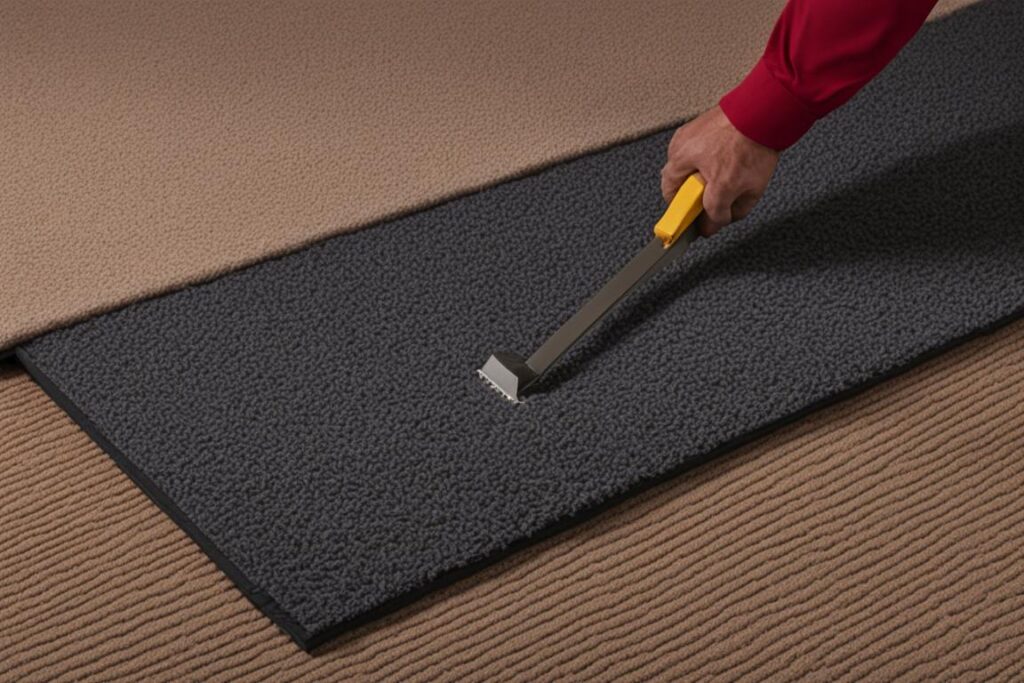
Common Causes of Carpet Bumps
1. Improper Carpet Installation: When the carpet installation is not done correctly, it can lead to loose edges and subsequent bumps. This can happen when the carpet tack strip is not installed at the proper distance from the baseboard or when the wrong carpet padding is used.
2. Deteriorating Backing: Over time, the backing of the carpet can deteriorate, causing the carpet to become loose and develop bumps. This can occur due to wear and tear, exposure to moisture, or aging of the carpet.
3. Environmental Factors: Environmental factors such as high humidity levels can affect the condition of the carpet. Excessive moisture in the air can cause the carpet fibers to expand, leading to bumps and ripples.
4. Compromised Carpet Padding: The quality and condition of the carpet padding play a crucial role in maintaining a smooth and even carpet surface. If the padding is worn out, damaged, or insufficiently thick, it can result in uneven surfaces and lumps.
To ensure a flawless and bump-free carpet, it is essential to address the underlying causes of carpet bumps and take appropriate measures to rectify them. Whether it’s proper carpet installation, replacing deteriorating backing, controlling environmental factors, or using the right carpet padding, each element contributes to maintaining a smooth and visually appealing wall-to-wall carpeting.
The Importance of Carpet Stretching
Carpet stretching plays a crucial role in maintaining the appearance and longevity of your wall-to-wall carpet. This process involves the use of specialized tools and techniques to eliminate bumps and ripples, creating a smooth and flawless surface.
Two essential tools utilized in carpet stretching are the power stretcher and the knee kicker. The power stretcher is an automated tool that offers consistent stretching across the entire length and width of the carpet. It ensures uniform tension, resulting in a professional finish. On the other hand, the knee kicker is a smaller, more affordable tool that requires manual effort. It is used to stretch smaller sections of the carpet, particularly around corners and tight spaces.
When performing carpet stretching, a combination of both the power stretcher and knee kicker can yield optimal results. The power stretcher is typically used to stretch the carpet from wall to wall, achieving a consistent tension throughout the entire surface. The knee kicker complements this process by focusing on specific areas that require additional stretching, such as corners or edges.
Benefits of Carpet Stretching:
- Eliminates bumps and ripples for a smooth carpet surface
- Enhances the overall appearance of the room
- Improves the door swing functionality
- Prevents premature wear and tear
- Increases the lifespan of the carpet
Carpet stretching not only eliminates aesthetic imperfections but also helps maintain the integrity of the carpet by preventing further damage. It is important to prioritize regular carpet maintenance, including stretching, to ensure a consistently beautiful and long-lasting carpet.
| Advantages of Power Stretcher | Advantages of Knee Kicker |
|---|---|
| Consistent stretching across the entire carpet surface | Flexibility for targeting specific areas |
| Efficient for larger carpeted areas | Perfect for tight corners and small sections |
| Provides professional results | Time and cost-effective |
By understanding the importance of carpet stretching and utilizing the appropriate tools, you can ensure a flawless and appealing carpet that enhances the overall aesthetics of your space.
Repairing Damaged Carpet for a Flawless Look
In addition to carpet stretching, repairing damaged areas of the carpet is crucial for maintaining a flawless appearance. Whether it’s due to wear and tear, accidental spills, or pet damage, addressing carpet issues promptly can ensure a uniform and appealing look for your flooring.
Carpet repair involves a process of removing and replacing damaged sections of the carpet that are beyond repair. This helps eliminate noticeable patches, tears, or unsightly stains, resulting in a carpet with a seamless and uniform appearance.
Steps for Repairing Damaged Carpet
- Identify the damaged areas: Inspect your carpet thoroughly to locate all the damaged sections that need to be repaired.
- Remove the damaged carpet: Gently cut out the damaged section of the carpet using a carpet cutter or utility knife. Be careful not to damage the surrounding areas.
- Prepare the replacement piece: Measure the size of the damaged area and cut a replacement piece of carpet of the same size. Make sure it matches the color and texture of the existing carpet.
- Fit the replacement piece: Apply carpet adhesive or double-sided carpet tape to the edges of the cut-out area. Carefully place the replacement piece into the opening, making sure the grain direction matches the surrounding carpet.
- Blend the repaired section: Use a carpet brush or comb to blend the repaired section with the rest of the carpet, ensuring a seamless transition.
For larger or more complex repairs, it’s advisable to seek professional assistance from a carpet repair specialist.
The Benefits of Repairing Damaged Carpet
- Enhanced appearance: Repairing damaged areas restores the carpet’s visual appeal, creating a uniform and flawless look throughout the space.
- Extended carpet lifespan: Promptly addressing carpet damage prevents it from spreading and becoming more extensive, allowing you to enjoy your carpet for a longer period without the need for complete replacement.
- Cost-effective: Replacing small damaged sections is more economical than replacing the entire carpet, saving you money in the process.
- Preservation of investment: By repairing damaged carpet, you protect your initial investment in the flooring, maintaining its value and attractiveness.
Remember, regular maintenance and prompt repairs contribute to the overall longevity and visual appeal of your carpet. It’s recommended to address any carpet damage as soon as it is noticed to prevent further deterioration.
Image:

| Repairing Damaged Carpet | Benefits |
|---|---|
| Eliminates noticeable patches, tears, or stains | Enhanced appearance |
| Preserves the uniformity of the carpet | Extended carpet lifespan |
| Saves money compared to complete replacement | Cost-effective |
| Protects the value of your carpet investment | Preservation of investment |
“Repairing damaged carpet not only improves the aesthetic appeal of your space but also helps protect your investment in this essential flooring. By promptly addressing carpet damage and using proper repair techniques, you can enjoy a flawless look that adds value to your home or office.”
The Process of Restretching a Carpet
Restretching a carpet is a multi-step process that requires careful attention to detail. By following these steps, you can effectively remove bumps and wrinkles from your carpet, restoring its smooth and flawless appearance.
Step 1: Removing Furniture
The first step in the restretching process is to remove all furniture from the area. This creates a clear space for you to work and allows for easier access to the carpet.
Step 2: Lifting the Carpet
Next, you’ll need to gently lift the edge of the carpet near the wall using pliers. Start at one end and gradually move along the wall, folding back the carpet as you go. This will expose the underlying floor and give you access to the carpet underpadding.
Step 3: Checking for Loose Objects
Before proceeding, take a moment to check for any loose objects on the floor. Remove any items that could get in the way during the restretching process, ensuring a smooth and safe working environment.
Step 4: Resetting the Underpadding
Once the carpet is lifted, you’ll need to reset the underpadding. Fold back the underpadding and secure it tightly to the subfloor, making sure it doesn’t overlap the carpet strip. This will provide a stable foundation for the restretched carpet.
Step 5: Using a Power Stretcher or Knee Kicker
Now it’s time to stretch the carpet. Depending on the size of the area and your preference, you can choose to use a power stretcher or a knee kicker. A power stretcher is a tool that applies consistent tension across the carpet, while a knee kicker is a smaller tool that allows for more precise stretching in smaller sections.
Step 6: Stretching the Carpet in Sections
Start by stretching the carpet in sections, working from the walls and moving towards the center of the room. Use the power stretcher or knee kicker to apply tension and gradually remove any wrinkles or bumps. Repeat this process until the entire carpet surface is smooth and taut.
Step 7: Pressing the Edges onto the Tack Strip
Once the carpet is stretched, use a putty knife to press the edges of the carpet onto the tack strip along the walls. This will secure the carpet in place and ensure a neat and finished appearance.
Step 8: Reattaching Baseboards and Wall Trim
Finally, reattach any baseboards and wall trim that were removed during the restretching process. This will give your room a polished look and hide any edges or gaps between the carpet and the walls.
By following these steps, you can successfully restretch your carpet and eliminate bumps and wrinkles. Remember, if you’re unsure or prefer professional assistance, it’s always best to consult a skilled carpet care provider.
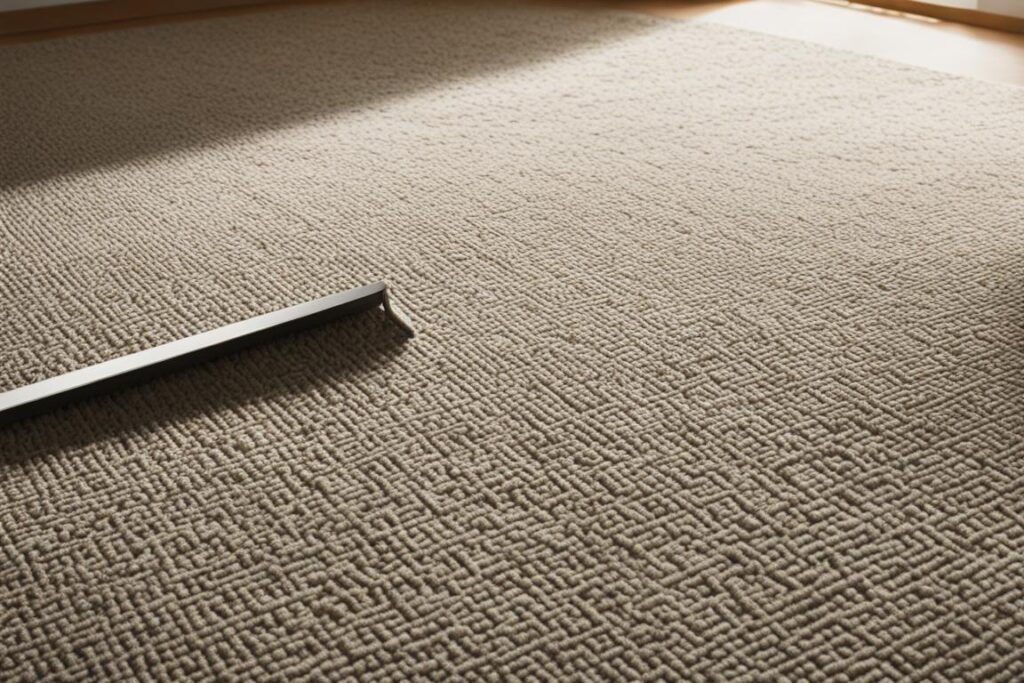
DIY Carpet Stretching Tips for Small Bumps
While professional carpet stretching is recommended for larger or more severe bumps, there are some DIY techniques you can try for small bumps. One such technique involves using a knee kicker to apply force and push the carpet towards the tack strip, effectively removing minor bumps.
Using a knee kicker can be an effective method for DIY carpet fixes. Here’s how to do it:
- Start by removing any furniture from the area so you have a clear workspace.
- Identify the small bumps in your carpet and determine if they are suitable for DIY repair.
- Position the knee kicker a few inches away from the small bump, facing towards the bump.
- With your knee or foot, apply firm and steady pressure to the knee kicker. This will push the carpet towards the tack strip and stretch out the small bump.
- Repeat this process for each small bump you want to fix, working your way across the affected area.
It’s important to note that while using a knee kicker can be effective for small bumps, it may not be as precise or durable as professional carpet stretching. Tight corners or slopes may also pose challenges for DIY repairs using a knee kicker. If you have larger or more complex issues with your carpet, it’s best to consult a professional for expert assistance.
Why consult a professional for larger or more complex carpet issues?
“Professional carpet stretching services offer the expertise and specialized tools necessary to address larger or more severe carpet bumps. They can accurately assess the cause of the bumps and determine the most appropriate method for repair. Additionally, professionals have the training and experience to ensure a long-lasting and visually appealing result. Consulting a professional can save you time, effort, and potential frustration while providing you with the best possible outcome for your carpet repair needs.”
– Carpet Care Experts
The Benefits of Regular Carpet Maintenance
Regular carpet maintenance is crucial for keeping your carpets in top condition and ensuring their longevity. By investing in proper carpet care services such as cleaning, stretching, and repair, you can enjoy the following benefits:
- Maintain a neat and even carpet surface: Regular maintenance helps keep your carpets free from bumps, ripples, and other imperfections, ensuring a smooth and uniform appearance throughout your space.
- Enhance the appearance of the room: Clean and well-maintained carpets can significantly improve the overall look and feel of any room. They add warmth, comfort, and style, making your space more inviting and aesthetically pleasing.
- Improve door swing functionality: Over time, carpets may become loose or uneven, affecting the functionality of doors. Regular carpet maintenance, including stretching and repair, eliminates bumps and ensures that doors swing freely without any hindrance.
- Promote the durability of the carpet: Carpet care services such as stretching and repair help address issues like loose fibers, worn-out areas, and damaged sections. By promptly addressing these problems, you can prevent further deterioration and extend the lifespan of your carpet.
“Investing in proper carpet care and maintenance can extend the lifespan of your carpet and save on replacement costs in the long run.”
When it comes to carpet care, it’s essential to rely on professional services. They have the expertise, tools, and techniques to ensure a flawless carpet surface and maximize its longevity.
| Carpet Care Services | Description |
|---|---|
| Carpet Cleaning | Professional cleaning removes dirt, stains, and allergens from your carpets, improving their appearance and maintaining a healthy indoor environment. |
| Carpet Stretching | Stretching techniques are used to remove bumps, ripples, and wrinkles from the carpet, ensuring a smooth and taut surface. |
| Carpet Repair | Professional carpet repair addresses damaged areas by replacing sections or repairing tears and burns, restoring the carpet’s integrity and appearance. |
Conclusion
Proper maintenance is crucial for keeping your wall-to-wall carpet in its best condition. If you’re dealing with unsightly bumps or ripples, carpet stretching and repair techniques can help restore it to a smooth and flawless state. By understanding the causes of carpet bumps and utilizing the right tools and methods, you can easily eliminate these imperfections.
Regular carpet care can go a long way in ensuring the longevity and appearance of your carpet. This includes professional stretching and repair services. By investing in professional carpet maintenance, you can enjoy a beautiful carpet surface for years to come. Addressing significant carpet bumps or opting for professional assistance is highly recommended to achieve the best results.
Remember, a well-maintained carpet not only enhances the overall look of your space but also provides a comfortable and safe environment for you and your family. So make sure to prioritize carpet maintenance, care, and repair to keep your carpet in top shape. And when you need an expert touch, trust experienced carpet care providers to deliver professional stretching services and ensure your carpet stays smooth and flawless.
FAQ
How can I remove bumps from my wall-to-wall carpet?
You can remove bumps from your wall-to-wall carpet by utilizing carpet stretching techniques. Professional stretching tools like power stretchers and knee kickers can help eliminate these bumps and give your carpet a smooth appearance.
What are the causes of carpet bumps?
Carpet bumps can be caused by improper carpet installation, deteriorating backing, environmental factors like humidity, and compromised carpet padding.
Why is carpet stretching important?
Carpet stretching is important because it helps remove bumps and ripples from the carpet, resulting in a smooth and flawless appearance. It also promotes the durability and longevity of the carpet.
How can I repair damaged sections of my carpet?
You can repair damaged sections of your carpet by removing and replacing the damaged areas. This helps maintain a uniform appearance without any noticeable patches or tears.
What is the process of restretching a carpet?
The process of restretching a carpet involves removing furniture, lifting the edge of the carpet near the wall, resetting the underpadding, stretching the carpet using a power stretcher or knee kicker, and pressing the edges onto the tack strip.
Are there any DIY tips for small carpet bumps?
For small carpet bumps, you can try using a knee kicker to apply force and push the carpet towards the tack strip. However, it is recommended to consult a professional for larger or more complex issues.
What are the benefits of regular carpet maintenance?
Regular carpet maintenance, including stretching and repair, maintains a neat and even carpet surface, enhances the appearance of the room, improves door swing functionality, and promotes the durability of the carpet.
What is the importance of professional carpet care services?
Professional carpet care services, such as cleaning, stretching, and repair, ensure a flawless carpet surface and prolong the longevity of the carpet. They can also save you on replacement costs in the long run.
Where can I find experienced carpet care providers?
You can find experienced carpet care providers by conducting an online search, asking for recommendations from friends or family, or contacting local carpet care companies in your area.
